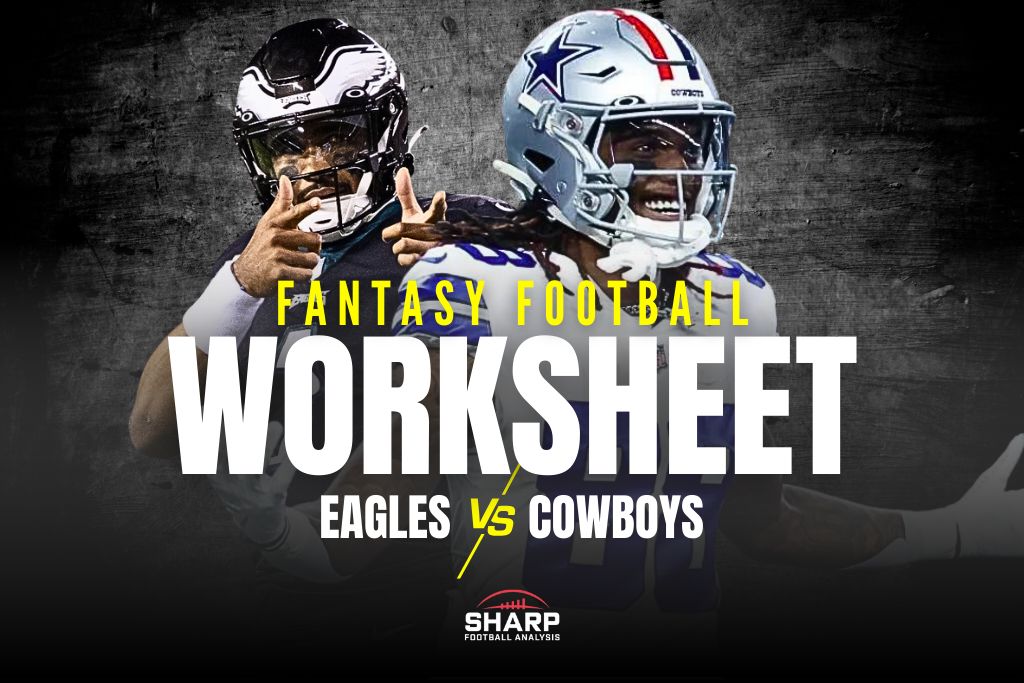The Worksheet, a comprehensive fantasy football preview by Rich Hribar, breaks down everything you need to know about the Week 1 matchup between the Eagles and Cowboys in the NFL Kickoff Game.
Find a breakdown of every Week 1 NFL game in our Worksheet Hub.
| Dallas | Rank | @ | Philadelphia | Rank |
|---|---|---|---|---|
| 7.5 | Spread | -7.5 | ||
| 20.0 | Implied Total | 27.5 | ||
| 20.6 | 21 | Points/Gm | 29.0 | 5 |
| 27.5 | 31 | Points All./Gm | 18.1 | 1 |
| 64.9 | 5 | Plays/Gm | 65.1 | 4 |
| 61.5 | 17 | Opp. Plays/Gm | 59.8 | 3 |
| 5.0 | 26 | Off. Yards/Play | 5.6 | 11 |
| 5.8 | 28 | Def. Yards/Play | 4.8 | 1 |
| 38.86% | 27 | Rush% | 56.29% | 1 |
| 61.14% | 6 | Pass% | 43.71% | 32 |
| 46.08% | 22 | Opp. Rush % | 39.68% | 5 |
| 53.92% | 11 | Opp. Pass % | 60.32% | 28 |
- The Eagles have not lost a Week 1 game at home since 2010 (4-0).
- The Eagles allowed a league-low 26.4 yards per possession in 2024.
- Philadelphia forced a three and out on a league-best 39% of opponent possessions.
- The Eagles allowed 1.63 points per drive in 2024, second in the league.
- Philadelphia allowed a touchdown on 17.5% of opponent possessions, third in the league.
- Dallas allowed a touchdown on 27.6% of opponent possessions, 31st in the league.
- Dallas had a 29% lower red zone touchdown rate compared to their opponents in 2024, the worst differential in the league.
- The Eagles scored 68 red zone touchdowns in 2024, fifth in the league.
- Philadelphia scored 17 touchdowns from outside of the red zone in 2024, second in the league.
- The Eagles scored on 50% (12 of 24) of their possessions against Dallas in 2024.
Trust = spike production for that player
Quarterback
Jalen Hurts (TRUST): It was another strong season for Hurts in 2024, despite hardly having his full cupboard of pass catchers for most of the season and throwing only 361 passes (only 20 more than Daniel Jones).
Hurts unlocked a few things under Kellen Moore.
The Eagles used motion on 50.8% of Hurts' dropbacks.
That was only in the middle of the league, but the Eagles were 28th in pre-snap motion (28% of Hurts’ dropbacks) in 2023.
That was significant in terms of results.
With the use of pre-snap motion, Hurts was second in the NFL in rating (116.6), completing 69.3% of his passes (10th) for 8.9 yards per pass attempt (2nd) and a 7.3% touchdown rate (5th).
He threw 13 touchdowns to 2 interceptions using motion.
Without pre-snap motion, Hurts was 17th in rating (91.0), completing 68.1% of his passes (5th) for 7.2 Y/A (19th) and only a 2.7% touchdown rate (31st).
Any questions surrounding Hurts' entering 2025 stem from his working with another coordinator after Moore took the head coaching job in New Orleans.
Hurts will be his sixth offensive coordinator in the NFL under Kevin Patullo.
Patullo has been with the Eagles through most of the run, so hopefully, he can borrow from the best of those play callers to max out Hurts.
Even if Patullo does not direct this passing game in the same fashion as Moore did, Hurts has added avenues for increased passing production through a healthier offense and the Eagles being pushed more in 2025.
A.J. Brown, DeVonta Smith, and Dallas Goedert were on the field together for only 79 of Hurts' dropbacks in the regular season (18.1%).
Brown and Smith were on the field together for only 58.8%.
Just by fielding a complete roster, the Eagles can throw the ball more effectively through the air.
The question here will be whether the Eagles can be pushed enough to keep them throwing.
Hurts averaged 17.8 dropbacks in the first half of games last year, which was 14th in the league.
But in the second half of games, he averaged only 11.3 dropbacks, which was 36th.
The Eagles are touchdown favorites against a Dallas team they decimated in both outings a year ago.
Granted, Dak Prescott did not play in either game, but the Eagles mopped up Dallas 34-6 in Week 10 and then came back in Week 17 to throttle them 41-7.
Hurts also did not play in the second game, but he ended the first matchup as the QB3 in weekly scoring, completing 14 of 20 passes for 202 yards (10.1 Y/A) with 2 touchdowns, adding another 2 touchdowns and 56 yards rushing (29.7 fantasy points).
Dallas has several question marks on the defensive side of the ball to open the season.
They are coming off a season in which they ranked 29th in passing points allowed per attempt (0.485).
Dallas was overwhelmed when they did not apply pressure to the opposing passer, allowing 7.8 yards per pass attempt (28th) and a 4.7% touchdown rate (22nd).
The Cowboys may not have Trevon Diggs available in full as he missed the entire preseason recovering from an ACL injury.
Diggs was activated off PUP after the final preseason weekend.
He is practicing, but even if he does suit up in Week 1, we should not expect him to be the same player as two years ago right off the bat.
We also have a fallout from the Micah Parsons trade.
Dallas had a 33.5% pressure rate without Parsons last season compared to a 37.3% pressure rate with him on the field.
That is the difference between being fifth in the league and dropping down to 18th.
Since drafting Parsons in 2021, the Cowboys have allowed 5.6 yards per play with him off the field, which ranks 30th in the league.
Dallas allowed a 5.0% touchdown rate in 2024 with Parsons off the field, which was 27th.
The Cowboys did bring in Matt Eberflus to helm the defense this season.
Eberflus has historically played more coverage over his tenure in Indianapolis and Chicago.
His defenses have only played man coverage at a 12.9% rate (2nd lowest) and blitzed at a 19.1% rate (3rd lowest).
Over the past three years in Chicago, his defenses led the NFL in the rate of Cover 2 (18.8%) and were fifth in Cover 3 (40.6%).
If looking for Dallas to give Hurts some trouble, he did have issues with shell coverages last year.
Against Cover 2 and Cover 3 last season (233 dropbacks), Hurts averaged 7.4 Y/A (20th), a 1.6% touchdown rate (25th), and took a sack on a league-high 11.2% of his dropbacks.
Hurts feasted against man coverage, finishing second with a 130.6 rating, throwing for a league-high 9.9 Y/A, and a 10.8% touchdown rate (5th).
Dak Prescott: 2024 was just about a lost season for Prescott.
He suffered a torn hamstring during the eighth game of the year, which forced him to miss the remainder of the season.
Pairing that with Prescott turning 32 this July, and the severity of his hamstring injury may be the final nail in his dwindling rushing output.
Prescott has rushed for 1.7 points per game over the past four seasons after averaging 4.2 per game over his first five seasons.
Even before the injury, Prescott was on a career-low 3.8% touchdown rate, and his 6.9 yards per pass attempt were his fewest in a season since 2017.
Prescott was a top-eight scorer in points per game in four of five seasons before last year.
The addition of George Pickens is an upgrade and clean fit with CeeDee Lamb, and Dallas can be one of the pass-heaviest teams in the league.
Brian Schottenheimer has changed his stripes some since his early days.
In his past three seasons as a coordinator, his teams have ranked 4th, 9th, and 10th in dropbacks.
This team should have to throw for success, especially early in the season.
This running game is a significant concern to open the season, and Dallas has moving parts on the offensive line.
Zack Martin retired this offseason, replaced by rookie Tyler Booker.
Left tackle Tyler Guyton has missed the preseason with a knee injury.
He is expected to play on Thursday, but will be coming off a lengthy absence.
While the weaponry is improved and the passing volume should remain high, Dallas is not in a glowing spot to open the season.
Dallas is a heavy underdog with a pedestrian team total, facing an Eagles defense that allowed a league-low 11.7 passing points per game in 2024.
Only two quarterbacks (Jayden Daniels and Baker Mayfield) posted 20 or more passing points against the Eagles last year.
That is right on par with Vic Fangio’s history.
He has not had a pass defense finish in the back half of the league in passing yardage allowed since 2005.
Nine of his past 12 defenses have been inside the top 10 in fewest yards allowed through the air.
Prescott has had some fantasy success against Fangio, albeit on a limited sample size.
Prescott has averaged 20.3 fantasy points per game in three outings against Fangio defenses.
He has not thrown more than 2 touchdowns in any of those matchups, but he has averaged 7.7 Y/A.
Philadelphia also has some moving parts of its own to work around on defense.
The team lost Josh Sweat, Milton Williams, Darius Slay, Avonte Maddox, and Isaiah Rodgers in free agency and traded C.J. Gardner-Johnson this spring.
Those moving pieces early in the season can open up some opportunities here.
I can also envision a scenario where Prescott has plenty of garbage time and Dallas is chasing the scoreboard.
Still, I will be handling Prescott as a volume-based QB2 to start the season based on the layout and lower-end team total for Dallas.
Running Back
Saquon Barkley: Barkley is coming off a historic season, racking up 2,283 yards on offense with 15 touchdowns.
He led the NFL in rushing attempts (345) and rushing yards (2,005) while also sitting out Week 18.
Barkley had a career-high 42% success rate as a runner.
13.4% of his runs went for 10 or more yards, the highest career rate.
He averaged 2.64 yards before contact per run, which is also the highest rate of his career.
23.8% of his runs resulted in a first down or touchdown: surprise, the highest rate of his career.
Only 17.1% of his runs failed to gain yardage.
Barkley only faced a light box on 18.6% of his runs, which was 41st in the league.
However, with teams forced to come up and defend the run while also accounting for Jalen Hurts, those stacked boxes allowed him to break long runs when he got to the second level untouched.
Barkley had 1,072 yards rushing on his 46 gains of 10 or more yards.
He had 7 touchdown runs from outside the red zone, the most since Chris Johnson in 2009 (8).
Barkley had 1,072 yards rushing on gains of 10 or more yards, trailing only Adrian Peterson in 2012 (1,428), Johnson in 2009 (1,231), and Jamal Lewis in 2003 (1,134) for a season in the 2000s.
Those explosive runs addressed some of the concerns we had about Barkley joining the Eagles, specifically the potential loss of receiving work and short scoring opportunities.
Barkley was targeted on a career low of 14.7% of his routes.
His previous low before joining the Eagles was 19.6%.
That rate was 12.2% when the Eagles had A.J. Brown, DeVonta Smith, and Dallas Goedert available.
Hurts and the Tush Push also impacted Barkley.
Barkley was 14th in red zone points at the position last year, and although he fell short of that output, his expected production ranked 11th.
Barkley had just three runs from the one-yard line last year, which was 29th among running backs.
Hurts had 15, which led the league.
Barkley had another three runs from the two-yard line, the same number as Hurts.
When you have a season like Barkley’s, you will, of course, hear about the upcoming regression expected to take place.
Special seasons are hard to replicate, something we have long lived with at the running back position.
The word “regression” is not a complete boogeyman. We are only using it to explain that Barkley’s 2024 season was a perfect storm.
The Eagles do have some offensive line parts to address in the opener, with Landon Dickerson questionable to be available in Week 1 due to a meniscus injury.
The team also lost right guard Mekhi Becton in free agency, elevating Tyler Steen into a starting role.
While two new guards do pose some concerns, the layout for the season opener is strong for a lead running back.
We have the Eagles as touchdown favorites against a run defense that allowed 4.4 yards per rush to running backs in 2024 (21st) while allowing a first down or touchdown on 23.8% of running back runs (24th).
Dallas allowed 1.54 yards before contact on running back runs (25th).
In their two games against the Cowboys, Philadelphia backs rushed 2.10 yards before contact.
Dallas did hold their own in the Week 10 matchup, allowing 78 total yards on 15 touches to Barkley without a touchdown.
Due to the blowout, Barkley did not even play in the fourth quarter of that game.
In the Week 17 rematch, Barkley then roughed them up for 169 total yards on 33 touches.
That said, when the Eagles were large favorites last season, Barkley was milder as a fantasy producer.
He averaged 16.5 fantasy points per game over the five weeks as a favorite of a touchdown or more, with two RB1 scoring weeks over those games.
He averaged 24.8 points per game in his other weeks with tighter layouts.
That is not going to push us off a running back in an ideal setting for production as a front-end RB1.
Cowboys RBs: Dallas has revamped its backfield in 2025.
The team signed veteran free agents to one-year contracts in Javonte Williams and Miles Sanders while drafting Jaydon Blue in the fifth round (149th).
Blue is inactive for the season opener, so things are a bit clearer with Williams and Sanders sharing this backfield.
This preseason, we did not see Williams log a single rushing attempt, which is some signal that he is at least the favorite to log the most snaps in the season opener.
Williams has been a shell of his early career efficiency since suffering a devastating knee injury during the 2022 season.
During his first two seasons in the NFL, Williams led all running backs with a broken tackle per 6.5 rushing attempts.
He ranked 33rd over the past two seasons with a broken tackle every 19.7 attempts.
In 2024, Williams averaged 3.7 yards per rush and ranked 42nd out of 46 backs with 100 or more attempts.
His 2.38 yards after contact per rush was dead last on that list.
Dallas hopes that Williams can rebound like J.K. Dobbins did last year, but if not, Williams was a low-leverage signing.
At worst, Williams still showed that he can contribute as a pass protector.
He was second at the position in pass blocking snaps (110) and 10th in pass blocking grade.
This is not a spot to go crazy chasing Williams as more than a touchdown-dependent FLEX, attached to a massive road favorite.
Sanders is coming off two injury-plagued seasons in Carolina.
Sanders only had 79 touches with the Panthers last season, missing six games with an ankle injury.
He did close the season on a positive note.
In Carolina’s Week 18 game, Sanders had 20 touches for 116 yards and 2 touchdowns.
This preseason, Sanders rushed 7 times for 15 yards.
Sanders is best kept on fantasy benches for the season opener.
The Eagles were second in points allowed per game to backfields (16.8), mainly due to playing ahead heavily.
In two games against the Eagles last season, Dallas running backs rushed 44 times for 181 yards (4.1 YPC) without a touchdown.
The losses of Milton Williams and Josh Sweat up front will open the door for early-season variance, but with Dallas as heavy road dogs here, it is tough to chase front-end production from this Dallas backfield.
Wide Receiver
A.J. Brown: Brown missed the majority of the preseason with a hamstring injury, but he returned to practice the week leading up to Week 1 and appears good to go for the opener.
Brown did not play in four games and had only 67 receptions (his fewest since 2021) and 97 targets (his fewest since his rookie season), but still managed to reach 1,000 yards (1,079) and 7 touchdowns.
The volume was down for Brown last season due to the nature of the Philadelphia offense, which tended to take its foot off the gas in the second half of games, but he was just as effective as ever.
He posted 3.04 yards per route run, second in the NFL behind Puka Nacua (3.57).
He collected 35.9% of the team’s targets when he was on the field, which was WR4 on the season.
We only had a small sample where the Eagles had all of Brown, DeVonta Smith, and Dallas Goedert on the field.
However, Brown led the team on those plays with 37.5% of the targets and 50.5% of the air yards.
Brown led the NFL with 4.46 yards per route (not a made-up number) on plays with only one or two wide receivers on the field.
The other thing that held Brown back in the counting stats department was that the Eagles flooded teams in 2024.
As a result, Brown averaged 5.0 targets per game in the first half of games last season (WR5), but with the Eagles only having a 39.6% dropback rate in the second half of games, Brown averaged only 2.5 targets per game after halftime (WR60).
Brown had only 32 total targets in the second half of games last season.
In two games against Dallas last year, Brown had a total of five targets in the second half of those outings.
Given the implied layout here, we are not anticipating a ton of pass volume, which can force Brown to live as a hyper-efficient fantasy option.
Prescott’s involvement in this game can help push the team towards a more passing-oriented approach, at least.
Add to that the fact that the Dallas secondary is softer to start the year, and there is still an upside run for Brown if we get pushback.
The changes we expect for the Dallas defense under Eberflus should lead to more diversity in the target tree, however.
Brown earned a target on 38.7% of his routes against man coverage last season compared to a 22.7% rate against zone coverage.
CeeDee Lamb: Lamb once again carried the Dallas passing game in 2024, catching 101 passes for 1,194 yards and 6 touchdowns over 15 games.
Lamb accounted for 32.3% of the Dallas targets when he was on the field, which was seventh among wide receivers.
He averaged 6.7 receptions (6th) for 79.6 yards per game (8th) despite working for half the year with backup quarterback play.
Lamb was hurt by the absence of Prescott and his offseason holdout, averaging a career-worst 11.8 yards per catch.
His depth of target went from 8.6 yards downfield with Prescott to 7.0 yards without him.
Despite the pedestrian usage impacted by quarterback play, Lamb was still excellent on his own merit.
He averaged 3.52 yards per route against man coverage, which was third in the league.
Lamb missed two games and still had 73 more targets than the next closest wide receiver on the roster.
Even with the addition of George Pickens, Lamb has room to shed some overall targets and remain at the front of the league.
This is not a great individual matchup, but we should get plenty of target opportunities for Lamb as a volume-based WR1.
Lamb only appeared in one of the games against the Eagles last season, catching 6 of 10 targets for 21 yards in the Week 10 matchup.
It would not be out of the question to see Lamb push double-digit targets here with improved quarterback play.
The Eagles were excellent inside and out against wideouts in 2024.
They allowed 7.1 yards per target to outside receivers (second) and 7.0 yards per target to slot receivers (fifth).
With the losses of Darius Slay and Avonte Maddox, Philadelphia will be working around a new unit of defensive backs to open the year.
There is an added opportunity here to catch the secondary in motion early in the season as they figure things out.
If Kelee Ringo or Adoree' Jackson is not reliable as a third option, they could be forced to move Cooper DeJean around more this season after their pass defense took off a year ago when the rookie locked down duties as the nickel back.
Jakorian Bennett was added in August from the Raiders as another option once he is up to speed with the defense opposite Quinyon Mitchell on the outside.
DeVonta Smith: Smith had career-low marks in targets (89) and receiving yards (833) but also missed four games.
On a per-game basis, Smith averaged more receptions (5.2) than in 2023 (5.1), while his yardage (64.1 yards per game) was on par with 2023 (66.6 yards per game).
He also scored 8 times, which was a career high.
His 2.14 yards per route were the best rate of his career.
Smith closed the season on a high note, scoring 4 times over his final four games and having a pair of 100-yard games over that span.
Smith played a career-high 47.5% of his snaps in the slot under Kellen Moore after rates of 10.6%, 21.5%, and 24.3% to open his career.
He had 5 of his touchdowns from the slot.
Will we achieve the same usage under Kevin Patullo?
Patullo has been with the Eagles for most of the run, so hopefully he can draw on what has worked.
This matchup can even the playing field for Smith, as Dallas is expected to play much more zone coverage under Eberflus.
Smith had more even splits against all coverages, receiving a target on 24.8% of his routes against man coverage compared to 22% against zone coverages.
The primary factor at play will be how much the Eagles throw the football overall, which will impact his outcome as a WR3/FLEX versus an upside WR2.
Smith had games of 2-14-0 (3 targets) and 6-120-2 (7 targets) against Dallas a year ago, but he also only had 3 total targets in the second half of those games.
George Pickens: Pickens has not delivered on upside to this point, but he did flash promise once again.
He averaged 2.94 yards per route versus man coverage (WR7).
CeeDee Lamb is the unquestioned alpha in Dallas, but he has plenty of targets to share.
Lamb missed two games and still had 73 more targets than the next closest wide receiver on the roster, accounting for 32.3% of the Dallas targets when he was on the field.
Pickens is being inserted into a better offense with improved quarterback play.
To this point in his career, Pickens has averaged over 15.0 yards per reception every year while catching passes from Kenny Pickett (129), Russell Wilson (58), Mitch Trubisky (46), Justin Fields (45), and Mason Rudolph (15).
15.4% of his career targets have been inaccurate.
The only receivers with a higher off-target rate with as many targets over that span are Diontae Johnson (17.9%), Amari Cooper (15.9%), Davante Adams (15.9%), and D.J. Moore (15.5%).
Since entering the NFL, Prescott is seventh in accuracy rate when throwing to wide receivers.
Even if Pickens remains the same player as a field stretcher and dependent on big plays, this is a fit and an upgrade for all parties.
Since Pickens entered the league, 28.3% of his career targets have been 20 or more yards downfield.
No player has a higher rate with as many targets as Pickens over the span.
Since entering the NFL in 2016, Prescott is fourth in rating on those deep throws (108.7) and eighth in accuracy.
Those opportunities may not carry a huge matchup advantage here.
Under Vic Fangio, the Eagles play more shell coverage and protect against vertical passing more than anyone else.
On throws 20 or more yards downfield to wide receivers last season, the Eagles allowed a 24.6% completion rate (2nd) and only 4 touchdowns.
Philadelphia allowed the lowest explosive pass play rate in the league (6.0%).
We will need to see this version of Pickens have more diversity and make growth in expanding his game in Dallas.
The moving parts for the Eagles at outside cornerback and potential passing volume here keep the lights on for Pickens as a boom-or-bust WR3.
Jahan Dotson: Dotson is not much more than a long-shot single-game DFS dart.
Out of 80 wide receivers who ran 300 or more routes in 2024, Dotson was targeted on 8.2% of his routes, which ranked 79th on that list.
The only time he caught more than two passes in the regular season was Week 18, when the team rested starters.
KaVontae Turpin: Turpin received a contract extension this offseason, is expected to get more run as a receiver this season, and has been rumored to work out of the backfield in some capacity, like we saw with Marvin Mims in Denver to close last season.
Turpin was targeted on 25.5% of his routes last season (second on the team) with 2.06 yards per route (also second).
Turpin is not a starter in managed leagues out of the gates, but he does become an interesting single-game DFS play and someone that deeper-league gamers can get a look at in formats that allow you to set lineups after the Thursday and Friday games (such as FFPC).
Tight End
Dallas Goedert: Goedert only appeared in 10 games in 2024, averaging 4.2 receptions for 49.6 yards per game.
Despite the limited opportunities and time missed, Goedert was second in yards per route (2.20), his best season since 2021.
He only ran 79 routes all season with A.J. Brown and DeVonta Smith on the field, drawing the same rate of targets (21.4% of team targets on 15% of his routes) as Smith.
His 5.2 targets per game were TE14, but they can rise with the Eagles being challenged to throw more in 2025.
We have questioned whether that will be the case here in the opener, leaving Goedert as a matchup-based TE1 to start the season.
The Eagles were much more balanced against zone coverage-centric teams. We just need to see the top-down targets here.
Brown led the team with a target of 22.7% routes against zone, followed by 22% rates for Goedert and Smith.
Dallas had plenty of issues slowing down tight ends in 2024 to create some efficiency appeal, even if Goedert has limited target opportunities.
The Cowboys allowed 8.3 yards per target to tight ends (27th) and an 8.2% touchdown rate (30th) to the position.
Jake Ferguson: Ferguson was second on the team in targets (86) but was unable to build on his breakout 2023 season.
Ferguson only managed 494 yards on his 59 receptions without a touchdown.
After averaging 10.7 yards per catch in 2023, Ferguson only averaged 8.4 yards per catch last season.
He also missed three games due to an MCL sprain and a concussion.
Impacted by the loss of Prescott, Ferguson only averaged 7.4 yards per catch (3.6 air yards per target) with the backup passers.
He managed only 22.9 yards per game after Prescott’s injury, after averaging 47.7 yards per game prior.
Prescott's return can help Ferguson get back on track, but he now has to deal with the addition of George Pickens.
The most appealing part of Ferguson last offseason was that he was set up to be second on the team in targets behind CeeDee Lamb.
Ferguson accounted for 23.8% of the team’s targets when he was on the field, which was TE9.
Pickens moves him further down the target tree, and we now have to question what we have in terms of a player to bet on, based on talent versus opportunity.
Ferguson has averaged only 9.6 yards per catch through three seasons.
He has averaged only 4.5 air yards per target through three seasons.
That puts Ferguson on the board as a fringe starter in fantasy circles to open the season.
The Eagles allowed a league-low 5.7 yards per target to tight ends in 2024.
Zack Baun established himself as one of the better coverage linebackers in the NFL last year, earning a contract extension this offseason.
However, their 4.9% touchdown rate ranked 21st, which is notable if you are chasing a touchdown and jailbreak game script for Ferguson.

More Week 1 Fantasy Breakdowns From The Worksheet:
| Matchup | Time |
|---|---|
| Cowboys @ Eagles -- FREE | NFL Kickoff Game |
| Chiefs vs. Chargers -- FREE | Friday Night Football |
| Bucs @ Falcons | Sunday -- 1 p.m. ET |
| Bengals @ Browns | Sunday -- 1 p.m. ET |
| Dolphins @ Colts | Sunday -- 1 p.m. ET |
| Raiders @ Patriots | Sunday -- 1 p.m. ET |
| Cardinals @ Saints | Sunday -- 1 p.m. ET |
| Steelers @ Jets | Sunday -- 1 p.m. ET |
| Giants @ Commanders | Sunday -- 1 p.m. ET |
| Panthers @ Jaguars | Sunday -- 1 p.m. ET |
| Titans @ Broncos | Sunday -- 4:05 p.m. ET |
| 49ers @ Seahawks | Sunday -- 4:05 p.m. ET |
| Lions @ Packers | Sunday -- 4:25 p.m. ET |
| Texans @ Rams | Sunday -- 4:25 p.m. ET |
| Ravens @ Bills -- FREE | Sunday Night Football |
| Vikings @ Bears -- FREE | Monday Night Football |

















